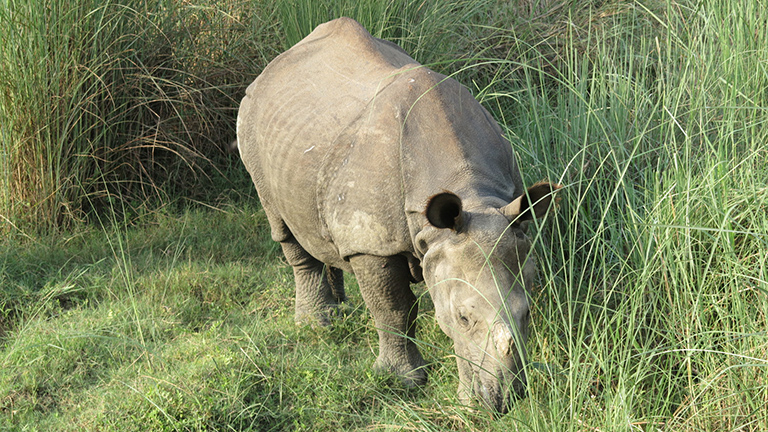The Mitsui & Co. Environment Fund
Introduction to Grant Projects
INDEX="29"
NAME="Conserving rare species by assessing the risk of infection in an Asian biodiversity hotspot"
TYPE="研究助成,"
YEAR="2018年度,"
AREA="アジア,"
KIND="大学,"
ORG="Hokkaido University, Laboratory of Wildlife Biology and Medicine, Graduate School of Veterinary Medicine Professor: Toshio Tsubota"
Hokkaido University, Laboratory of Wildlife Biology and Medicine, Graduate School of Veterinary Medicine Professor: Toshio Tsubota
Conserving rare species by assessing the risk of infection in an Asian biodiversity hotspot
Research grant
- Project Description
The purpose of this study is to clarify the current situation and evaluate infection and extinction risk in regard to infectious diseases in rare species in Nepal, one of the biodiversity hotspots in Asia, through international joint research. Specifically, the study will focus on tuberculosis, which is having a severe effect on species such as the Asian elephant, Indian rhinoceros, Asian black bear, and sloth bear. The results will be used to formulate a vision and action plan with the aim of preventing rare species from going extinct. [No. R18-0029]
Mitsui & Co. Environment Fund FY2018 Research Grants List (PDF 193KB)
- Fields
- Global Environment
- Grant year
- FY2018 Research Grants
- Grant term
- 3 years (April 2019 - March 2022)
- Grant amount
- ¥7,500,000
- Activity region
- Nepal

Overview of the Organization

- Project organization
- Hokkaido University
Laboratory of Wildlife Biology and Medicine, Graduate School of Veterinary Medicine - Representative
- Professor: Toshio Tsubota
- Profile
- Specialist field: Zoo and wildlife medicine, conservation
Affiliated academic societies: Japanese Society of Zoo and Wildlife Medicine, Japanese Society of Veterinary Science, The Mammal Society of Japan, etc.
Background: Obtained a PhD in Veterinary Medicine from the University of Hokkaido School of Veterinary Medicine, where since 2007 he has subsequently served as assistant, assistant professor, and latterly in his continuing role as professor. - Research record
-
- Paudel, S., Nakajima, C., Mikota, S., Gairhe, K., Maharajan, B., Subedi, S., Poudel, A., Sashika, M., Shimozuru, M., Suzuki, Y. & Tsubota, T.: Mixed mycobacterium tuberculosis lineage infection in two elephants, Nepal. Emerg. Inf. Dis. 25(5): 1031-1032, 2019.
- Shimozuru, M., Shirane, Y., Tsuruga, H., Yamanaka, M., Nakanishi, M., Ishinazaka, T., Kasai, S., Nose, T., Masuda, Y., Fujimoto, Y., Mano, T. & Tsubota, T.: Incidence of multiple paternity and inbreeding in high-density brown bear populations on Shiretoko Peninsula, Hokkaido, Japan. J. Heredity 110(3): 321-331, 2019. doi: 10.1093/jhered/esz002
- Fuchs, B., Yamazaki, K., Evans, A. L., Tsubota, T., Koike, S., Naganuma, T. & Arnemo, J. M.: Heart rate during hyperphagia differs between two bear species. Biol. Lett. 15: 20180681, 2019. http:://dx.doi.org/10.1098/rsbl.2018.0681
- Paudel, S., Mikota, S. K. & Tsubota, T.: Tuberculosis threat in Asian elephants. Science 363(6425), 356, 2019. DOI: 10.1126/science.aaw2342
- Miyazaki, M., Shimozuru, M. & Tsubota, T.: Skeletal muscles of hibernating black bears show minimal atrophy and phenotype shifting despite prolonged physical inactiveity and starvation. PLoS ONE 14(4): e0215489, 2019. other 161 documents.
- WEB site
- http://www.vetmed.hokudai.ac.jp